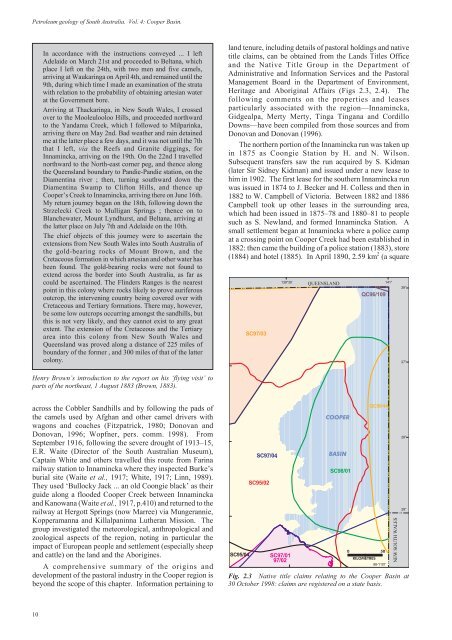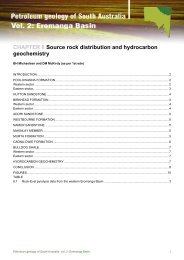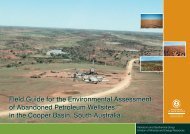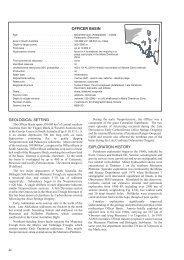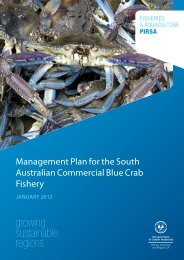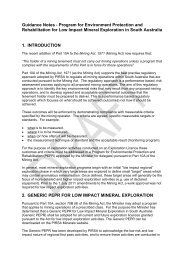Chapter 2: History of petroleum exploration and development - PIRSA
Chapter 2: History of petroleum exploration and development - PIRSA
Chapter 2: History of petroleum exploration and development - PIRSA
Create successful ePaper yourself
Turn your PDF publications into a flip-book with our unique Google optimized e-Paper software.
Petroleum geology <strong>of</strong> South Australia. Vol. 4: Cooper Basin.In accordance with the instructions conveyed ... I leftAdelaide on March 21st <strong>and</strong> proceeded to Beltana, whichplace I left on the 24th, with two men <strong>and</strong> five camels,arriving at Waukaringa on April 4th, <strong>and</strong> remained until the9th, during which time I made an examination <strong>of</strong> the stratawith relation to the probability <strong>of</strong> obtaining artesian waterat the Government bore.Arriving at Thackaringa, in New South Wales, I crossedover to the Mooleulooloo Hills, <strong>and</strong> proceeded northwardto the Y<strong>and</strong>ama Creek, which I followed to Milparinka,arriving there on May 2nd. Bad weather <strong>and</strong> rain detainedme at the latter place a few days, <strong>and</strong> it was not until the 7ththat I left, via the Reefs <strong>and</strong> Granite diggings, forInnamincka, arriving on the 19th. On the 22nd I travellednorthward to the North-east corner peg, <strong>and</strong> thence alongthe Queensl<strong>and</strong> boundary to P<strong>and</strong>ie-P<strong>and</strong>ie station, on theDiamentina river ; then, turning southward down theDiamentina Swamp to Clifton Hills, <strong>and</strong> thence upCooper’s Creek to Innamincka, arriving there on June 16th.My return journey began on the 18th, following down theStrzelecki Creek to Mulligan Springs ; thence on toBlanchewater, Mount Lyndhurst, <strong>and</strong> Beltana, arriving atthe latter place on July 7th <strong>and</strong> Adelaide on the 10th.The chief objects <strong>of</strong> this journey were to ascertain theextensions from New South Wales into South Australia <strong>of</strong>the gold-bearing rocks <strong>of</strong> Mount Brown, <strong>and</strong> theCretaceous formation in which artesian <strong>and</strong> other water hasbeen found. The gold-bearing rocks were not found toextend across the border into South Australia, as far ascould be ascertained. The Flinders Ranges is the nearestpoint in this colony where rocks likely to prove auriferousoutcrop, the intervening country being covered over withCretaceous <strong>and</strong> Tertiary formations. There may, however,be some low outcrops occurring amongst the s<strong>and</strong>hills, butthis is not very likely, <strong>and</strong> they cannot exist to any greatextent. The extension <strong>of</strong> the Cretaceous <strong>and</strong> the Tertiaryarea into this colony from New South Wales <strong>and</strong>Queensl<strong>and</strong> was proved along a distance <strong>of</strong> 225 miles <strong>of</strong>boundary <strong>of</strong> the former , <strong>and</strong> 300 miles <strong>of</strong> that <strong>of</strong> the lattercolony.l<strong>and</strong> tenure, including details <strong>of</strong> pastoral holdings <strong>and</strong> nativetitle claims, can be obtained from the L<strong>and</strong>s Titles Office<strong>and</strong> the Native Title Group in the Department <strong>of</strong>Administrative <strong>and</strong> Information Services <strong>and</strong> the PastoralManagement Board in the Department <strong>of</strong> Environment,Heritage <strong>and</strong> Aboriginal Affairs (Figs 2.3, 2.4). Thefollowing comments on the properties <strong>and</strong> leasesparticularly associated with the region—Innamincka,Gidgealpa, Merty Merty, Tinga Tingana <strong>and</strong> CordilloDowns—have been compiled from those sources <strong>and</strong> fromDonovan <strong>and</strong> Donovan (1996).The northern portion <strong>of</strong> the Innamincka run was taken upin 1875 as Coongie Station by H. <strong>and</strong> N. Wilson.Subsequent transfers saw the run acquired by S. Kidman(later Sir Sidney Kidman) <strong>and</strong> issued under a new lease tohim in 1902. The first lease for the southern Innamincka runwas issued in 1874 to J. Becker <strong>and</strong> H. Colless <strong>and</strong> then in1882 to W. Campbell <strong>of</strong> Victoria. Between 1882 <strong>and</strong> 1886Campbell took up other leases in the surrounding area,which had been issued in 1875–78 <strong>and</strong> 1880–81 to peoplesuch as S. Newl<strong>and</strong>, <strong>and</strong> formed Innamincka Station. Asmall settlement began at Innamincka where a police campat a crossing point on Cooper Creek had been established in1882: then came the building <strong>of</strong> a police station (1883), store(1884) <strong>and</strong> hotel (1885). In April 1890, 2.59 km 2 (a squareSC97/03QUEENSLAND139°30´ 141°QC96/10926°27°Henry Brown’s introduction to the report on his ‘flying visit’ toparts <strong>of</strong> the northeast, 1 August 1883 (Brown, 1883).across the Cobbler S<strong>and</strong>hills <strong>and</strong> by following the pads <strong>of</strong>the camels used by Afghan <strong>and</strong> other camel drivers withwagons <strong>and</strong> coaches (Fitzpatrick, 1980; Donovan <strong>and</strong>Donovan, 1996; Wopfner, pers. comm. 1998). FromSeptember 1916, following the severe drought <strong>of</strong> 1913–15,E.R. Waite (Director <strong>of</strong> the South Australian Museum),Captain White <strong>and</strong> others travelled this route from Farinarailway station to Innamincka where they inspected Burke’sburial site (Waite et al., 1917; White, 1917; Linn, 1989).They used ‘Bullocky Jack ... an old Coongie black’ as theirguide along a flooded Cooper Creek between Innamincka<strong>and</strong> Kanowana (Waite et al., 1917, p.410) <strong>and</strong> returned to therailway at Hergott Springs (now Marree) via Mungerannie,Kopperamanna <strong>and</strong> Killalpaninna Lutheran Mission. Thegroup investigated the meteorological, anthropological <strong>and</strong>zoological aspects <strong>of</strong> the region, noting in particular theimpact <strong>of</strong> European people <strong>and</strong> settlement (especially sheep<strong>and</strong> cattle) on the l<strong>and</strong> <strong>and</strong> the Aborigines.A comprehensive summary <strong>of</strong> the origins <strong>and</strong><strong>development</strong> <strong>of</strong> the pastoral industry in the Cooper region isbeyond the scope <strong>of</strong> this chapter. Information pertaining toSC95/04SC97/04SC95/02SC97/0197/02COOPERBASINSC98/01QC98/440 50KILOMETRES98-1107NEW SOUTH WALESFig. 2.3 Native title claims relating to the Cooper Basin at30 October 1998: claims are registered on a state basis.28°29°10


